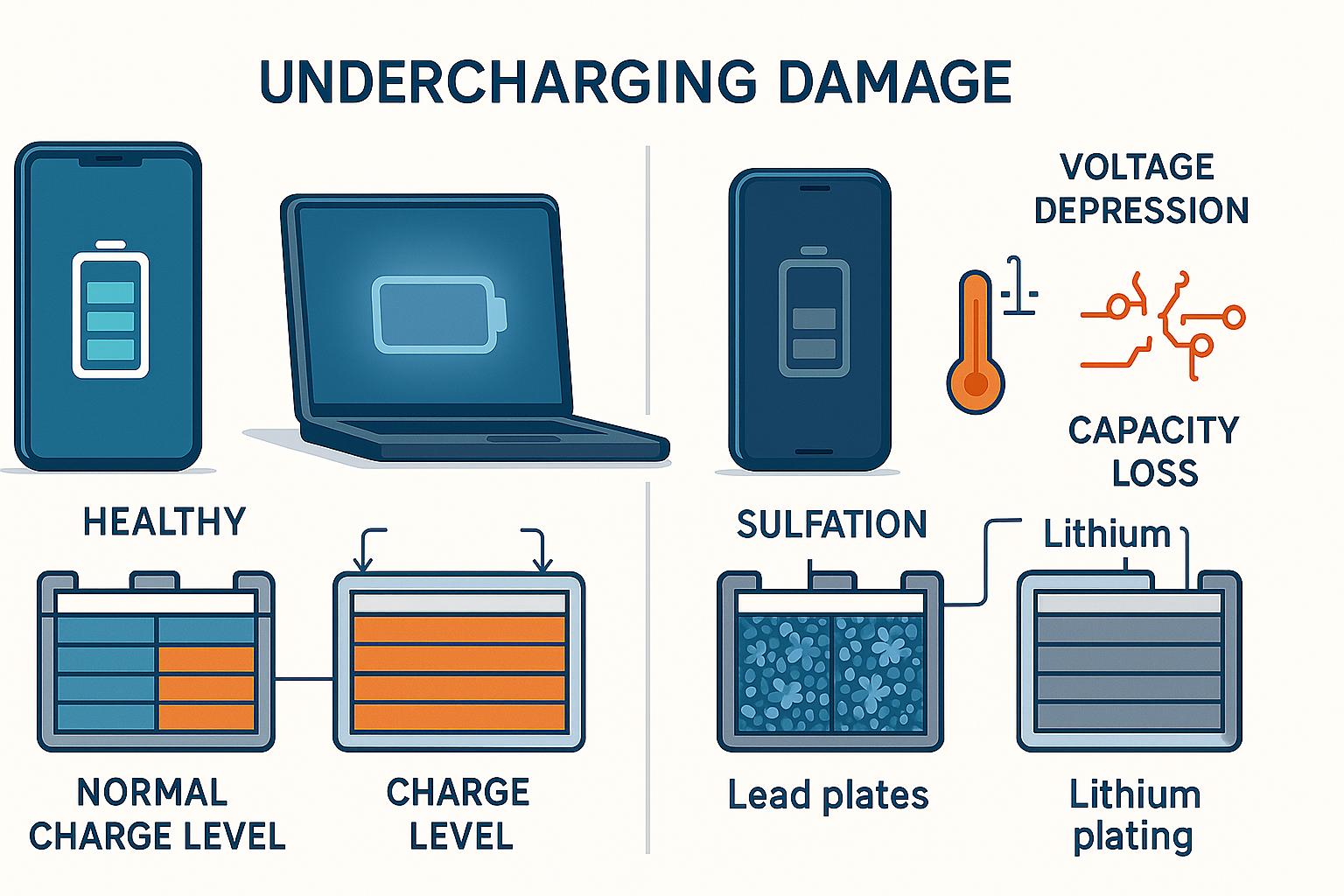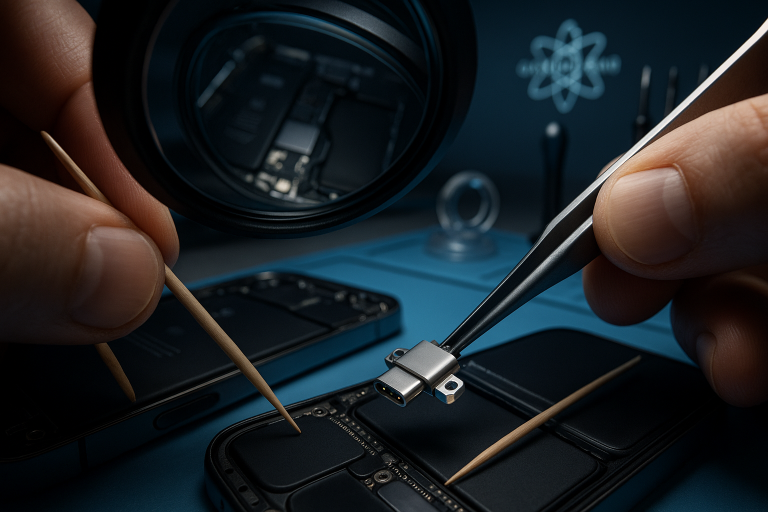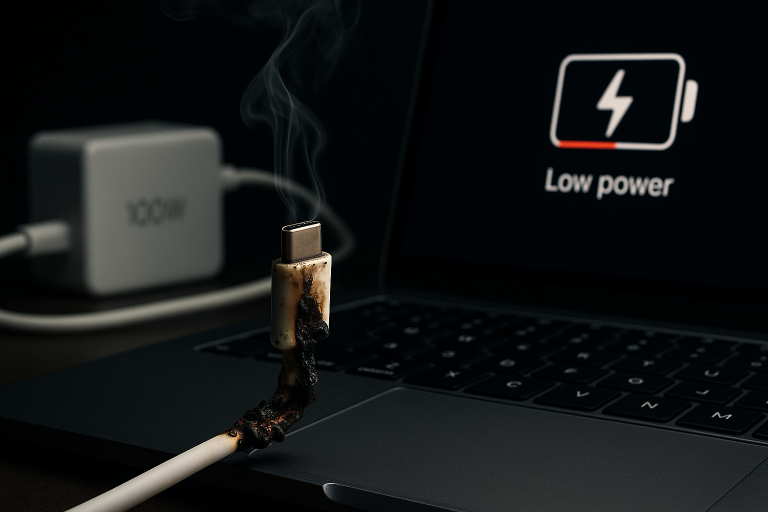What Is Undercharging? How It Damages Your Devices
Undercharging occurs when a battery or system consistently operates below its minimum required charge level, preventing it from reaching its optimal state of charge. Unlike complete discharge (where devices power off entirely), undercharging represents a state of chronic energy deficiency where devices remain functional but starved of necessary power reserves. This subtle yet destructive condition plagues everything from smartphones to industrial equipment, causing cumulative damage that often goes unnoticed until catastrophic failure occurs .
I. The Mechanisms of Undercharging Damage
1. Sulfation in Lead-Acid Batteries:
When lead-acid batteries remain in a partially charged state, lead sulfate crystals form on the battery plates. Initially reversible during proper charging, these crystals permanently harden during prolonged undercharging. This process reduces active material availability, decreases capacity, and increases internal resistance. Discover Battery notes that undercharging “allows lead sulphate to build up and plates to shed,” dramatically shortening battery life .
2. Voltage Depression in Lithium-ion Batteries:
Undercharged lithium-ion batteries experience reduced output voltage, forcing devices to draw more current to maintain performance. This increased current strain accelerates degradation through two mechanisms: electrode stress and electrolyte decomposition. The resulting capacity loss manifests as shorter runtimes and diminished device performance .
3. Acid Stratification:
A particularly insidious effect in undercharged lead-acid batteries is acid stratification, where concentrated acid settles at the bottom and diluted acid rises to the top. This creates uneven electrochemical reactions, accelerating corrosion and further reducing capacity. Discover Battery identifies this as a key reason “average battery life is declining” in automotive applications .
4. Increased Internal Resistance:
All battery types develop higher internal resistance when chronically undercharged. This resistance converts valuable energy into waste heat during operation, creating a vicious cycle where reduced efficiency demands more power from an already compromised battery .
| Damage Mechanism | Lead-Acid Batteries | Lithium-ion Batteries |
|---|---|---|
| Primary Chemical Process | Sulfation (irreversible crystal formation) | Lithium plating & electrolyte oxidation |
| Capacity Loss | Up to 30% in 3 months | 2-5% per month in severe cases |
| Structural Changes | Plate corrosion & shedding | Anode lattice degradation |
| Recovery Potential | Limited with pulse charging | Minimal once voltage depression occurs |
II. Device-Specific Impacts of Undercharging
Smartphones and Tablets:
- Sudden Shutdowns: As voltage drops below operational thresholds, devices power off unexpectedly despite showing residual charge
- Data Corruption: Unsaved work and critical updates are interrupted during unexpected shutdowns
- Accelerated Aging: Research indicates lithium-ion batteries lose approximately 20% capacity after 500 full cycles, but undercharging can double degradation rates
Laptop Computers:
- Performance Throttling: Modern processors automatically reduce clock speeds when voltage drops, causing noticeable slowdowns
- Battery Lifespan Reduction: Undercharged laptop batteries may last only 12-18 months versus the typical 2-3 year lifespan
- System Instability: Intermittent power delivery corrupts firmware updates and damages storage devices
Automotive & Deep-Cycle Batteries:
- Starting Failure: Undercharged car batteries lack cold-cranking amps for ignition, especially in winter
- Plate Sulfation: Discover Battery identifies this as the primary failure mode in start-stop vehicles
- Corrosion Acceleration: Continuous undercharging corrodes positive grids, permanently reducing capacity
HVAC and Industrial Systems:
- Compressor Damage: Undercharged refrigerant systems cause compressors to overheat, short-cycle, and eventually fail through “low pressure cut-out”
- Coil Freezing: Insufficient refrigerant leads to evaporator coil icing, reducing heat transfer efficiency
- Motor Burnout: Refrigerant also cools compressor motors; undercharging causes overheating and premature failure
| Symptom | Immediate Consequence | Long-Term Damage |
|---|---|---|
| Reduced Voltage Output | Device slowdowns/performance issues | Permanent capacity loss |
| Increased Operating Temperature | Surface warmth during use | Electrolyte breakdown & swelling |
| Intermittent Operation | Unexpected shutdowns | Circuit board damage & data corruption |
| Extended Charging Times | Longer waits for full charges | Accelerated chemical aging |
III. Prevention and Mitigation Strategies
1. Optimal Charging Practices:
- Partial Charging Cycles: Maintain lithium-ion batteries between 20-80% charge rather than full cycles
- Avoid Deep Discharges: Recharge devices before they drop below 20% capacity
- Regular Full Charges: For lead-acid batteries, perform monthly equalization charges to dissolve sulfate crystals
2. Smart Charging Technology Utilization:
- Manufacturer-Specific Features: Use tools like Apple’s Optimized Charging or Samsung’s 85% charge limit
- Battery Monitoring Systems: Implement IoT sensors for commercial batteries to track state-of-charge
- Manufacturer-Recommended Chargers: Always use chargers with correct voltage/current specifications
3. Environmental Management:
- Temperature Control: Keep batteries at 0-35°C (32-95°F) during charging and operation
- Ventilation: Ensure proper airflow around charging devices to prevent heat buildup
- Periodic Calibration: For smart devices, perform full discharge/charge cycles quarterly to maintain accurate battery indicators
4. Maintenance Protocols:
- Terminal Cleaning: Remove corrosion from lead-acid battery terminals monthly
- Refrigerant Checks: Schedule professional HVAC inspections to detect undercharged systems
- Software Updates: Install firmware updates containing battery management improvements
IV. The Hidden Costs of Undercharging
The consequences of chronic undercharging extend beyond immediate device failure. For consumers, it means premature replacement costs when batteries that should last 3 years fail in 18 months. Businesses face productivity losses when critical equipment fails unexpectedly—HVAC compressor replacements from undercharging can cost $1,500-$5,000. Environmentally, improperly maintained batteries contribute to the 180,000 metric tons of lithium-ion waste generated annually .
Perhaps most insidiously, undercharging creates false economies—users believe they’re preserving battery life by avoiding “overcharging,” unaware that undercharging causes equally severe damage. As Discover Battery notes: “In many respects, undercharging is as harmful as overcharging” .
Breaking the Cycle of Power Neglect
Undercharging represents a silent killer in our device-dependent world, causing progressive damage that often escapes notice until components fail catastrophically. By understanding the electrochemical mechanisms behind sulfation, voltage depression, and acid stratification, users can implement protective strategies tailored to their devices. The cornerstone of prevention lies in proactive power management—avoiding deep discharges, using smart charging features, maintaining optimal temperatures, and adhering to manufacturer-specific guidelines.
As battery technology evolves, future innovations may mitigate these issues through solid-state designs and advanced battery management systems. Until then, recognizing undercharging as equally damaging as overcharging represents the first step toward preserving our devices’ lifespan. By treating power management with the same vigilance as software updates and physical protection, users can ensure their devices deliver maximum performance throughout their intended operational life .




